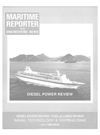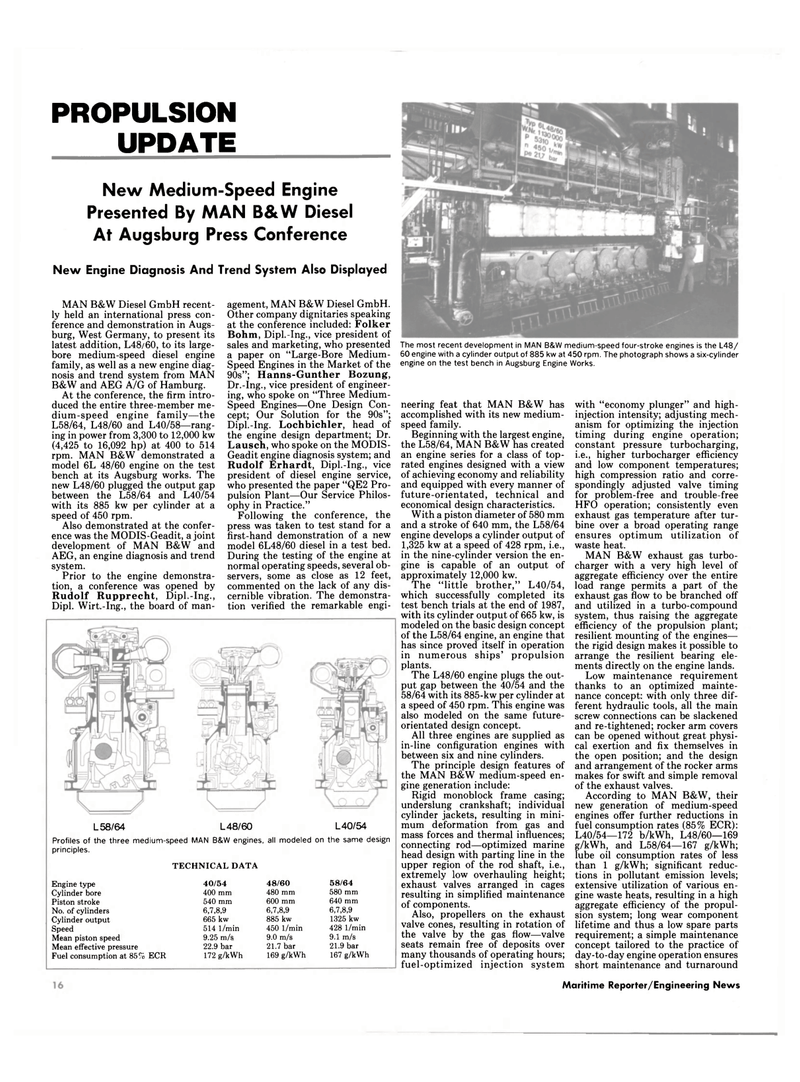
Page 14: of Maritime Reporter Magazine (July 1989)
Read this page in Pdf, Flash or Html5 edition of July 1989 Maritime Reporter Magazine
PROPULSION
UPDATE
New Medium-Speed Engine
Presented By MAN B&W Diesel
At Augsburg Press Conference
New Engine Diagnosis And Trend System Also Displayed
MAN B&W Diesel GmbH recent- ly held an international press con- ference and demonstration in Augs- burg, West Germany, to present its latest addition, L48/60, to its large- bore medium-speed diesel engine family, as well as a new engine diag- nosis and trend system from MAN
B&W and AEG A/G of Hamburg.
At the conference, the firm intro- duced the entire three-member me- dium-speed engine family—the
L58/64, L48/60 and L40/58—rang- ing in power from 3,300 to 12,000 kw (4,425 to 16,092 hp) at 400 to 514 rpm. MAN B&W demonstrated a model 6L 48/60 engine on the test bench at its Augsburg works. The new L48/60 plugged the output gap between the L58/64 and L40/54 with its 885 kw per cylinder at a speed of 450 rpm.
Also demonstrated at the confer- ence was the MODIS-Geadit, a joint development of MAN B&W and
AEG, an engine diagnosis and trend system.
Prior to the engine demonstra- tion, a conference was opened by
Rudolf Rupprecht, Dipl.-Ing.,
Dipl. Wirt.-Ing., the board of man- agement, MAN B&W Diesel GmbH.
Other company dignitaries speaking at the conference included: Folker
Bohm, Dipl.-Ing., vice president of sales and marketing, who presented a paper on "Large-Bore Medium-
Speed Engines in the Market of the 90s"; Hanns-Gunther Bozung,
Dr.-Ing., vice president of engineer- ing, who spoke on "Three Medium-
Speed Engines—One Design Con- cept; Our Solution for the 90s";
Dipl.-Ing. Lochbichler, head of the engine design department; Dr.
Lausch, who spoke on the MODIS-
Geadit engine diagnosis system; and
Rudolf Erhardt, Dipl.-Ing., vice president of diesel engine service, who presented the paper "QE2 Pro- pulsion Plant—Our Service Philos- ophy in Practice."
Following the conference, the press was taken to test stand for a first-hand demonstration of a new model 6L48/60 diesel in a test bed.
During the testing of the engine at normal operating speeds, several ob- servers, some as close as 12 feet, commented on the lack of any dis- cernible vibration. The demonstra- tion verified the remarkable engi-
L 58/64 L 48/60 L 40/54
Profiles of the three medium-speed MAN B&W engines, all modeled on the same design principles.
TECHNICAL DATA
Engine type 40/54 48/60 58/64
Cylinder bore 400 mm 480 mm 580 mm
Piston stroke 540 mm 600 mm 640 mm
No. of cylinders 6,7,8,9 6,7,8,9 6,7,8,9
Cylinder output 665 kw 885 kw 1325 kw
Speed 514 1/min 450 1/min 428 1/min
Mean piston speed 9.25 m/s. 9.0 m/s 9.1 m/s
Mean effective pressure 22.9 bar 21.7 bar 21.9 bar
Fuel consumption at 85% ECR 172 g/kWh 169 g/kWh 167 g/kWh
The most recent development in MAN B&W medium-speed four-stroke engines is the L48/ 60 engine with a cylinder output of 885 kw at 450 rpm. The photograph shows a six-cylinder engine on the test bench in Augsburg Engine Works. neering feat that MAN B&W has accomplished with its new medium- speed family.
Beginning with the largest engine, the L58/64, MAN B&W has created an engine series for a class of top- rated engines designed with a view of achieving economy and reliability and equipped with every manner of future-orientated, technical and economical design characteristics.
With a piston diameter of 580 mm and a stroke of 640 mm, the L58/64 engine develops a cylinder output of 1,325 kw at a speed of 428 rpm, i.e., in the nine-cylinder version the en- gine is capable of an output of approximately 12,000 kw.
The "little brother," L40/54, which successfully completed its test bench trials at the end of 1987, with its cylinder output of 665 kw, is modeled on the basic design concept of the L58/64 engine, an engine that has since proved itself in operation in numerous ships' propulsion plants.
The L48/60 engine plugs the out- put gap between the 40/54 and the 58/64 with its 885-kw per cylinder at a speed of 450 rpm. This engine was also modeled on the same future- orientated design concept.
All three engines are supplied as in-line configuration engines with between six and nine cylinders.
The principle design features of the MAN B&W medium-speed en- gine generation include:
Rigid monoblock frame casing; underslung crankshaft; individual cylinder jackets, resulting in mini- mum deformation from gas and mass forces and thermal influences; connecting rod—optimized marine head design with parting line in the upper region of the rod shaft, i.e., extremely low overhauling height; exhaust valves arranged in cages resulting in simplified maintenance of components.
Also, propellers on the exhaust valve cones, resulting in rotation of the valve by the gas flow—valve seats remain free of deposits over many thousands of operating hours; fuel-optimized injection system with "economy plunger" and high- injection intensity; adjusting mech- anism for optimizing the injection timing during engine operation; constant pressure turbocharging, i.e., higher turbocharger efficiency and low component temperatures; high compression ratio and corre- spondingly adjusted valve timing for problem-free and trouble-free
HFO operation; consistently even exhaust gas temperature after tur- bine over a broad operating range ensures optimum utilization of waste heat.
MAN B&W exhaust gas turbo- charger with a very high level of aggregate efficiency over the entire load range permits a part of the exhaust gas flow to be branched off and utilized in a turbo-compound system, thus raising the aggregate efficiency of the propulsion plant; resilient mounting of the engines— the rigid design makes it possible to arrange the resilient bearing ele- ments directly on the engine lands.
Low maintenance requirement thanks to an optimized mainte- nance concept: with only three dif- ferent hydraulic tools, all the main screw connections can be slackened and re-tightened; rocker arm covers can be opened without great physi- cal exertion and fix themselves in the open position; and the design and arrangement of the rocker arms makes for swift and simple removal of the exhaust valves.
According to MAN B&W, their new generation of medium-speed engines offer further reductions in fuel consumption rates (85% ECR):
L40/54—172 b/kWh, L48/60—169 g/kWh, and L58/64—167 g/kWh; lube oil consumption rates of less than 1 g/kWh; significant reduc- tions in pollutant emission levels; extensive utilization of various en- gine waste heats, resulting in a high aggregate efficiency of the propul- sion system; long wear component lifetime and thus a low spare parts requirement; a simple maintenance concept tailored to the practice of day-to-day engine operation ensures short maintenance and turnaround 16 Maritime Reporter/Engineering News

 13
13

 15
15
